Are Terpenes Lipids?
What are lipids?
Lipids are naturally occurring, organic compounds primarily distinguished by their long, nonpolar (hydrocarbon) chains. These compounds are typically insoluble in water (think of how oil sits on top of water) and need a non-polar solvent to dissolve. When in a liquid state, lipids are referred to as oils, but when they are solid, they are often called fats. You likely know about lipids already through your exposure to human nutrition. Lipids make up fatty acids (though not all lipids are fatty acids), which come in three forms: saturated, unsaturated, and polyunsaturated. Saturated lipids are ones that have a chain with only single bonds. Unsaturated lipids have a chain with one double bond and polyunsaturated lipids have chains with multiple double bonds. The most well known lipid is trans-fat, which is an unsaturated fat. Because of the double bond of trans-fat, it has a higher melting point and is more difficult for the body to break down and metabolise.

Terpenes are unique lipids
Now that we understand what lipids are, we can look at terpenes. Terpenes are non-saponifiable lipids, or simple lipids, and do not contain fatty acids. Rather, terpenes have an isoprene base and are categorized depending on the number of isoprene units it has. Terpenes with two isoprene units are called monoterpenes, three units are sesquiterpenes, four units are diterpenes, five units are sesterterpenes, and six are triterpenes. An example of a monoterpene is myrcene, know for its pleasant clove smell. Terpenes come in a wide array of variations, which explains the countless smells and tastes that these naturally occurring compounds have.
In a past article, we mentioned that you should be cautious of MCT oil because of its connection to lipid pneumonia. While MCT oil and terpenes are both lipids, terpenes do not cause lipid pneumonia. Unlike MCT oil, terpenes do not contain fats or fatty acids. Lipid pneumonia is caused by fats entering the lungs which causes inflammation and irritation. Without fats, lipid pneumonia will not occur, meaning your terpenes are safe to use in aromatic products.
Now that you understand the basic composition of terpenes, you can more accurately use them in your products. To get started, visit our blog on mixing terpene isolates and blends. Already know what you’re doing? Check out our terpene blends and isolates to make a selection!











